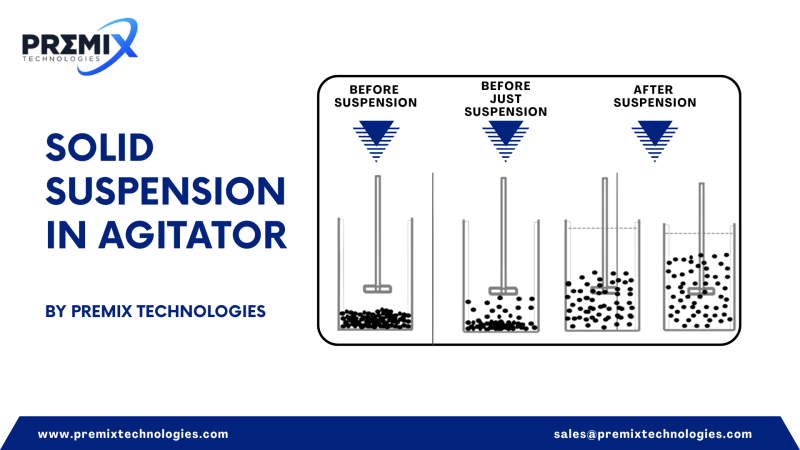At Premix Technologies, we understand the importance of achieving optimal solid suspension in your mixing processes. When solid particles meet a liquid in a tank, preventing them from settling and clumping at the bottom is crucial. This blog post dives into the world of solid suspension, exploring its various levels, causes of buildup, and how to achieve a perfectly uniform mix.
Understanding Solids Suspension Levels
In industrial mixing, we can achieve three main levels of solid suspension:
- On-Bottom Suspension: This is the bare minimum to prevent solid buildup. Particles are constantly moving but remain primarily near the tank's bottom.
- Off-Bottom Suspension: Here, the flow is strong enough to keep particles circulating between the bottom and the impeller, preventing them from resting on the tank floor. However, there's no uniform distribution throughout the tank.
- Full or Uniform Suspension: This is the ideal scenario for processes requiring consistent contact between solids and liquids. A high flow rate ensures particles are suspended throughout the entire tank volume, reaching even the topmost areas.
Why It Matters: Choosing the Right Suspension Level
Understanding the necessary level of suspension is key. Achieving full suspension can require up to 25 times more power compared to on-bottom suspension. This translates to higher costs in terms of equipment and operation. For instance, applications like feeding filters don't necessarily require uniform suspension, saving on costs.
Common Culprits of Solids Buildup and Detection Methods
Solid buildup is a persistent challenge in many mixing applications. Here are the main culprits:
- Changing process conditions
- Incorrect impeller design
Small, fast-spinning impellers might create the illusion of sufficient pumping, but they often lack the reach to properly agitate the entire tank, leading to buildup on the sides.
Detecting buildup can be tricky. Here are a couple of methods:
- Weighted spiked ball: This ball is lowered along the tank's side. The spikes catch on any buildup, indicating its depth.
- Thermal imaging: This method is particularly effective when there's a temperature difference between the slurry and the surrounding area. Buildup shows up as cooler sections within the tank.
Optimizing Agitator Design for Effective Suspension
While impeller speed might seem like the most important factor, that's often not the case. High-speed, small-diameter impellers create a limited zone of influence, failing to achieve uniform distribution or prevent buildup at the edges.
The ideal solution typically involves a larger-diameter impeller operating at a slower speed. This generates a broader zone of influence with high torque, promoting a homogeneous mixture throughout the tank.
Beyond Impellers: The Role of Tank Design
Tank design also plays a vital role. The tank's aspect ratio and bottom shape can significantly influence solids settling patterns. In many cases, tanks incorporate baffles to improve flow patterns and prevent buildup.
Premix Technologies: Your Partner in Optimal Solids Suspension Application
At Premix Technologies, our team of experts possesses the knowledge and experience to design the perfect agitation solution for your specific needs. We'll help you achieve efficient and effective solid suspension, ensuring consistent product quality.
Contact us today to discuss your requirements and discover how Premix Technologies can elevate your mixing processes!


